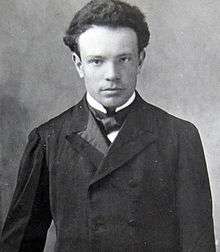Belfagor
| Ottorino Respighi |
|---|
 |
|
Operas
|
- for the similarly named demon see Belphegor
Belfagor (premiere 26 April 1923) is an Italian-language opera by the composer Ottorino Respighi to a libretto by Claudio Guastalla (1880-1948) based on the comedy Belfagor of Ercole Luigi Morselli (1882-1921), itself loosely based on the novella Belfagor arcidiavolo by Niccolò Machiavelli. It was premiered in 1923 at La Scala in Milan, under the baton of Antonio Guarnieri, since Toscanini was unavailable. The cast featured Irish soprano Margaret Burke Sheridan as Candida, tenor Mariano Stabile as her lover Baldo, and baritone Francesco Merli as the titular Belfagor, a "arcidiavolo" who tries to marry a human maiden while in disguise as a nobleman, using gifts of money to her father.[1]
The première obtained a «full and warm» approval, with several curtain calls for the composer,[2] but the opinion of the critics was divided, ranging from the enthusiasm of Marinetti, enchanted by the futuristic aspects of the opera, and of the music critic S. A. Lucani, to those who judged opera and libretto absolutely not enjoyable.[3] Gaetano Cesari wrote that this work looked like an attempt, not fully accomplished, to merge in a comic opera «the fabolous and the clownish, the miracolous and the sentimental» and that the comic expressivity was damaged by the absence of «assertiveness of the melodic plan and its capacity to develop rapidly».[4]
Roles
| Role | Voice type | Premiere Cast, 26 April 1923[5] |
|---|---|---|
| Candida | soprano | Margaret Sheridan |
| Baldo | tenor | Francesco Merli |
| Belfagor | baritone | Mariano Stabile |
| Mirocleto (father) | bass | Gaetano Azzolini |
| Olympia (mother) | mezzo-soprano | Anna Gramegna |
| Fidelia (sister) | soprano | Thea Vitulli |
| Maddalena (sister) | soprano | Cesira Ferrari |
| an old man | baritone | |
| a boy | soprano | |
| Menica | mezzo-soprano | Ida Mannarini |
| Don Biagio | bass | Giovanni Azzimonti |
| Majordomo | baritone | |
| 1st companion | baritone | |
| 2nd companion | baritone | |
| Chorus (s,a,t,b) | ||
Instrumentation
Belfagor is scored for the following instruments:[6]
piccolo, 2 flutes , 2 oboes, English horn, E-flat clarinet, 2 clarinets, 2 bassoons, double bassoon, 4 horns, 3 trumpets, 3 trombones, bass tuba, timpani, triangle, ratchet, drum, bass drum, cymbals, tam-tam, xylophone, handbells, bells, celesta, harp, strings.
Synopsis
Prologue
Belfagor appears in a small village. He explains to the apothecary Mirocleto, who has three daughters of marriageable age, to be on mission from the underworld. Belfagor has the task to discover if the marriage is truly a hell for the mankind, as many people arriving in the afterworld say. To accomplish his task Belfagor, who has a lot of money at his disposal, has to find a wife and spend ten years with her.
Act 1
Belfagor turns up at Mirocleto's home, disguised as the handsome and immensely rich Ipsilonne. Fidelia and Maddalena are bewitched by Ipsilonne, but he chooses the third daughter, Candida, who instead shows disregard for him. Mirocleto and his wife, Olimpia, attracted by the money, consent to give Candida to Ipsilonne, but the girl is in despair, since she is in love with the sailor Baldo.
Act 2
One month later, in a luxurious castle of Ipsilonne. Candida has been forced to marry Ipsilonne, but the marriage has not yet been consummated. Finally Candida, with the aid of Baldo, manages to flee, after making Ipsilonne believe that she would spend the night with him.
Epilogue
Candida and Baldo find refuge thanks to the provost. Belfagor appears again in the village, this time disguised as a vagabond. Belfagor makes the doubt creep in Baldo, letting him believe that Candida lost her virginity with Ipsilonne, who this way achieved his aim of having fun with a young maiden before disappearing. Candida tries vainly to convince Baldo that the vagabond is a liar. Baldo gives in to her pleas only when Candida, in despair, asks the Madonna a miracle, and the bells start playing by themselves.
Recordings
1989: Lamberto Gardelli, Hungarian Radio and Television Chorus. Hungarian State Orchestra, CD Hungaroton HCD 12850-51[7] | |
|---|---|
Candida: Sylvia Sass |
Mirocleto: László Polgár |
References
- ↑ Hungarian book review Volume 32; Volume 32 Magyar Könyvkiadók és Könyvterjesztők Egyesülése 1990 "Belfagor was Respighi's second opera; it tied him to the operatic stage for good. It was premiered in 1923 at La Scala in Milan, conducted by Antonio Guarneri, with an illustrious cast: the leading parts were sung by Mariano Stabile, Margaret Sheridan and Francesco Merli. The premiere was fairly successful, "
- ↑ "Belfagor di Respighi. La prima rappresentazione alla Scala". La Stampa (in Italian). Torino. 27 April 1923. p. 3. Retrieved 6 January 2015.
- ↑ Zidarich, Walter. "Belfagor di Claudio Guastalla e Ottorino Respighi: le vane comica e nazionalistica nel melodramma italiano del primo '900" (PDF) (in Italian). Université Paris 3 - Département d'études italiennes et roumaines. Retrieved 6 January 2015.
- ↑ Cesari, Gaetano (27 April 1923). Il Corriere della Sera (in Italian). Milano. Missing or empty
|title=(help) - ↑ "Première of Belfagor" (in Italian). amadeusonline. Retrieved 6 January 2015.
- ↑ "Ottorino RESPIGHI. Catalogo delle composizioni suddiviso per generi musicali: Opere liriche". l'Orchestra Virtuale del Flaminio (in Italian). Retrieved 2 January 2015.
- ↑ "Ottorino Respighi - Belfagor - Lamberto Gardelli (1989)". operaclass. Retrieved 6 January 2015.